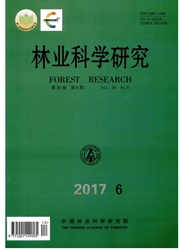

 中文摘要:
中文摘要:
[目的] 研究低磷胁迫对杉木幼苗各种抗氧化酶等生理指标的变化影响,探讨抗氧化酶活性与杉木耐低磷能力的关系,揭示低磷胁迫下杉木养分吸收的适应机制,阐明杉木体内生物大分子对低磷胁迫的响应。[方法] 通过设置不同磷浓度(0、0.25、0.50、1.00 mmol·L^-1 ) Hoagland营养液,模拟低磷胁迫试验,测定低磷胁迫对杉木幼苗的生理指标的影响,研究低磷胁迫对杉木幼苗养分吸收的影响机制以及测定杉木幼苗不同部位的光谱特性。[结果] 随着缺磷程度的增加,杉木幼苗中SOD活性、CAT活性以及叶绿素a、叶绿素b和叶绿素总量均先升后降,根系中POD活性呈现出升高的趋势、MDA含量先降再升后降,叶片中POD活性和MDA含量先降后升。低磷胁迫对杉木幼苗根系和叶片吸收利用营养元素有显著影响。杉木苗根系所含的Mn随着缺磷程度的增加呈上升趋势,而Al和Cu先降后升,Fe和K则有所下降,Ca先升后降。此外,杉木叶片中Fe和Mn的积累量呈降低的趋势,Cu和K先升后降。低磷胁迫对杉木幼苗根系和叶片组织在3 367、2 924、1 736、1 630、1 380、1 1501 000 cm^-1处特征峰吸光值影响不同。[结论] 低磷胁迫下,杉木幼苗的根系和叶片会通过改变保护酶(SOD、CAT和 POD)活性抑制MDA形成,降低膜脂过氧化对细胞膜系统的破坏,通过增加对其他养分元素的吸收来规避损伤以及通过改变不同部位糖类、氨基酸和蛋白质等物质含量来适应低磷环境。
 英文摘要:
英文摘要:
[Objective] To investigate the response mechanism of low-P stress on the antioxidant enzyme activities, nutrient uptake and bio-macromolecules of Chinese fir. [Method] The effects of low phosphorus stress on the physiological indexes of Chinese fir (Cunninghamia lanceolata) seedlings, the mechanism of low phosphorus stress on the nutrient uptake of Chinese fir seedlings and the spectral characteristics of different parts of Chinese fir seedlings were studied by setting different phosphorus concentration in Hoagland nutrient solution. [Result] With the decrease of phosphorus level, the SOD activity, CAT activity, chlorophyll a, chlorophyll b and total chlorophyll content of Chinese fir seedlings rose at initial and then decreased. Low phosphorus stress made POD activity increase, and the MDA content decreased at first and then increased in the roots of Chinese fir. In the leaves, the POD activity and MDA content decreased at first and then increased. Low phosphorus stress had a significant effect on the absorption and utilization of nutrient elements in roots and leaves of Chinese fir seedlings. The content of Mn in Chinese fir roots showed an upward trend with the increasing level of P deficiency. The content of Al and Cu decreased at first and then increased, while the content of Fe and K decreased, and the content of Ca increased at first and then decreased. In addition, the accumulation of Fe and Mn in the leaves of Chinese fir showed a decreasing trend, and the accumulation of Cu and K increased and then decreased. On 3 367, 2 924, 1 736, 1 630, 1 380, 1 150~1 000 cm^-1 wavelength, low phosphorus stress had an effect on the root and leaf tissue where the light absorption value of characteristic peak were different. [Conclusion] Under low phosphorus stress, the root and leaf of Chinese fir inhibit the formation of MDA by changing the activity of protective enzymes (SOD, CAT and POD), and decrease the damage of membrane lipid peroxidation to the cell membrane system. They also avoid the damage of low
 同期刊论文项目
同期刊论文项目
 同项目期刊论文
同项目期刊论文
 期刊信息
期刊信息
